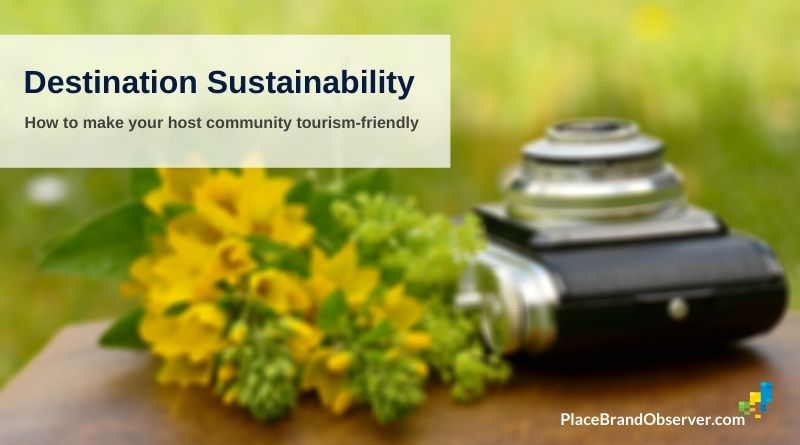The current travel freeze has provided a breather to many host communities living in popular tourist destinations. With tourism making a comeback post-COVID-19, locals may or may not want the kind of tourism like before. At this juncture, how can destination marketers or place branding professionals convince host communities to embrace tourism again?
Below the answers of our panel of place branding specialists (in alphabetical order – highlighted respondents are available for consulting, research, or as speakers).
 In partnership with the Sustainability Leaders Project: sharing and celebrating success stories of sustainable tourism leadership since 2012.
In partnership with the Sustainability Leaders Project: sharing and celebrating success stories of sustainable tourism leadership since 2012.
Our key takeaways:
- Have an honest conversation with your community stakeholders to rethink what really matters to them.
- Make your revised or new tourism strategy all about the locals and community benefits. Use the revenue earned from tourism (e.g. tourist tax) towards improving infrastructure and public facilities which benefit everybody.
- Earn the confidence of the locals, so that you can together restart tourism activities in your destination, at a pace which all are confident with.
- Highlight the importance of tourism for the local economy and jobs – how it is for the community’s own benefit.
- Avoid negative implications of tourism growth, such as displacement of locals due to unavailability of affordable housing because of Airbnb & Co.
- While still suffering from the pandemic, establish checks and balances to ensure a maximum of hygiene and health precautions at the destination.
This is just a snapshot of the very intriguing and insightful answers from specialists around the world, which you find in full length below.
Andrew Hoyne
Hoyne Design / Book Andrew as speaker
Some local communities may have enjoyed a quieter time, and not want the previous volume of people to return. However, as most economies will be crushed, there will be a desperate desire for businesses to create revenue at any cost. There needs to be a balance.
Ensure there’s a slow rebuild, rather than a mad rush of people flooding back. And communicate with locals, to remind them that the purpose is not to disrupt their quality of life, but to create economic opportunity for local businesses, as well as job creation for local people.
Caio Esteves
Once again, it is a question of engagement and sharing the strategic function of tourism and how this activity can positively impact the local economy.
It does not seem to be a matter of persuasion, but rather the creation of a shared vision among the stakeholders. In addition, organising programs, processes, and activities that are capable of involving a large part of the local community, making the tourism income impact the largest number of people possible, either in a direct form of revenue for the provision of some type of service or indirectly, through the qualification of public facilities, public spaces, urban infrastructure, etc.
Günter Soydanbay
Soydanbay Consulting / Book Günter as speaker
My first line of defense would be to educate the locals, infuse empathy at the public level, and fight stereotypes.
The COVID-19 crisis demonstrated how preeminent the economy is. So, I would start an awareness campaign about the strong link between tourism and the vitality of the local economy.
Finally, I would try to direct travellers towards off the beaten track, so that I would diffuse overtourism. Back then, this was almost impossible, for people wanted to see the main tourist attractions. Now, they will demand to be in more isolated places.
Heather Skinner
If destination communities do not want tourists at all, then destination managers should think very carefully about whether or not they should persuade these communities to welcome them again. Places should, primarily, serve the people who live and work in them. Just because people may want to visit these places does not mean they should visit them.
The vast majority of research into the benefits of tourism to communities focuses solely or primarily on the economic argument, and people will tend to welcome tourists if they think there may be a benefit to them. Those that perceive little personal benefit may not be so welcoming.
However, tourism can have many other benefits to communities, and perhaps destination managers should consider issues wider than the economic imperative. For example, the way a place’s infrastructure can improve through investment due to tourism, which will benefit everyone who uses a place, whether they live or work there, or visit.
Some places had ‘enough’ tourists already before this unprecedented pandemic hit, and some had more than enough, leading to ‘tourismophobia’ and anti-tourism sentiments being expressed. Destination managers cannot simply go back to business as usual. For many places that model did not work.
We need to rethink post-pandemic tourism. As we move into recovery, we must also think about reform. What do we want tourism to look like in a post-pandemic world? Our communities must be involved in these discussions, and not just by paying lip service to stakeholder engagement, but by really involving communities in planning for restarting tourism, and by listening to their concerns.
Hjörtur Smárason
It is very important to focus on the welcoming committee. Fear of contagion can translate into fear of foreigners or visitors from ‘the outside’. If this is not tackled with internal information campaigns on how the risk of contagion is contained and the safety of the locals secured, you can create hostility that damages your reputation for years to come.
Jeannette Hanna
Trajectory / Book Jeannette as speaker
Many places are creating ‘Responsible Tourism Pledges’ that remind visitors that residents are part of the local ecosystem. Visitors are encouraged to respect the needs of residents as well as the natural environment.
Promoting authentic, off the beaten path experiences for visitors is also an important sustainability strategy. Invest in wayfinding (digital and physical) and itineraries that encourage visitors to explore beyond the usual. It’s important to have locals engaged in making those experiences safe and memorable. Recruiting, training, and rewarding locals to act as guides and navigators adds authenticity and memorable personalisation.
Joao Freire
Tourists should only be welcomed if they benefit the local people. Otherwise, there is no incentive for the local people to welcome them.
One of the problems with tourism is the availability of housing. It is important to balance the housing that is available to the local people versus housing available to the tourists. Other problems include the issues of overcrowding and access to cultural places. Places could address these issues by differentiating residents from nonresidents. By doing this, some infrastructures could be open exclusively for residents during certain times.
It is also important to channel part of the earnings of tourism to the local people. Local people should reap the benefits of tourism and not just experience the disadvantages of more expensive housing and goods, and overcrowded places. People in destination communities are also potential international tourists and certain infrastructures only exist because they are supported by tourists and tourism. For this reason, it is relevant that destination marketers have an internal communication plan that explains the potential benefits of tourism to the local people.
Juan Carlos Belloso
In the short term, some destination communities may not want tourists to come back. However, we may have to work helping understand the great value and contribution of sustainable tourism to local development through jobs, taxes, etc. Also, its unique ability to create access for the young population and other less favoured groups, and also making sure citizens understand the need to transform existing models to a more balanced, sustainable model for the destination.
Malcolm Allan
Branding and marketing professionals need to respect and show understanding of local peoples’ concerns about halting the attraction of tourists while they remain concerned about the potential of visitors to transmit the coronavirus to them. Unless they are confident that visitors have some form of proof that they have had and recovered from the virus or, when treatment is readily available, that they have been vaccinated.
Serious tourist businesses should establish these new ‘bona-fides’ of visitors before accepting bookings. Of course, this will be dependent on much larger scale testing for the virus, but to do otherwise would be reckless.
Martin Boisen
For the love of place / Researcher profile
First of all, I do not believe that there are communities that do not want tourists at all. Just by changing the word into ‘visitors’, the attitude starts shifting. The main challenge has been mass tourism in all its variations – along with the race to the bottom that it so often gives rise to.
Second, I’m not sure if we should try to ‘persuade’ communities to welcome tourists again. My hesitation stems from the fact that the question already implies what the outcome should be. I’m not so sure that should be the outcome for all places. It depends.
I do believe that it is essential that the many meaningful dialogues between residents and local/regional businesses we had before this crisis hit are continued and not put on hold until everything is back to normal. I do not want everything to go back to normal, and I know I’m not the only one. We’ve been discussing how tourism should change for a long time now. Now it’s time to act.
Robert Govers
Independent advisor / Speaker / Researcher
Show locals that the tourism recovery will be managed carefully, but – obviously – history might not work in their favour in making such arguments convincing.
Sebastian Zenker
You cannot force anyone to open up. Tourism has to prove its value again in some places first. Fear might lead to more xenophobia and avoiding tourists.
On the other hand, residents currently also experience how much they miss travelling and how much the local economy misses them as customers – so it is a good time to start to negotiate what kind of future tourism we want.
Todd Babiak
Don’t be defensive. Don’t try to convince communities it’s ‘good for them’ to experience overtourism. Be honest about what has worked and not worked in the past and use this moment to reset, to ask hard questions, and build a better plan with your community.
Take this time to listen and understand. It will take enormous courage, the courage to say no from time to time because your community wants to say no.
Tom Buncle
Yellow Railroad Consulting / Book Tom as speaker
Engage residents in developing a destination management plan. Start by asking “Do you want tourists here?” and then ask “If so, why?”. This will guide the type of tourism you develop and the type of visitors you seek to attract.
Assuming they do want some form of tourism, it will be important to enumerate the potential benefits (local revenue, jobs, support for local businesses, providing facilities for residents – such as restaurants, bars, museums, theatres, festivals, and other entertainment, plus local transport services – which might otherwise not survive without visitor revenue) and identify the risks associated with visitors, so they can be addressed before problems materialise.
Andrea Lucarelli
Respect your community and just start to ask them which are the conditions to restart. Fostering a sense of community and good hospitality is the best way to start. Use this crisis to rethink the model of running a destination. Take risks and be brave.
Bill Geist
Destination marketers must, at all times, be responsive to their community. If a community does not want tourists, then the DMO should pivot to identify ways that it can attract other types of visitors; the ones that are visitors but don’t look and act like the ones residents notice. Meeting attendees, site inspectors, business travellers are rarely seen as ‘the problem’ with tourism.
Cecilia Cassinger
It will be important to use a bottom-up approach to align the tourism strategy with the interests of the local communities. This needs to be done at an early stage of tourism development, to give them an actual voice in the process.
Hila Oren
Place branding and marketing professionals should avoid overdoing clumsy and unnatural attempts to encourage tourism. Rather than pushing, let it grow from the bottom, like grass root. That means that you should let the market do its thing – embrace and encourage private market participants.
People lost their income because of the coronavirus, and they had to find their alternatives. There are new initiatives that did not exist before and they are emerging from the field. We have to give them the chance and allow them to succeed. These initiatives are essentially micro-economy, which corresponds with the ‘pocket tourism’ concept.
Inga Hlin Pálsdóttir
It is important to have all stakeholders on board when reassessing the strategies for the future. If the conclusion is that the community does not want tourists at all, then you, of course, skip everything related to strategy making, marketing, or promotional material with regard to the community. The destination is nothing without its community or citizens and other stakeholders.
Irina Shafranskaya
I think that it’s time to rethink what the economic benefits of tourism are in reality. As most place marketing agencies are in charge of the economic effects like extra visitors or revenues, their rhetoric is still about this type of gains. But are there any other benefits – I think the place managers should reconsider this.
Jaume Marín
Local communities should be involved in the planning, as well as in the development of the strategies and action plans. We will have to look at tourists as temporary locals. We should start being proud of our culture, and proud of our tourists. So destinations should make a bigger effort in deciding which tourists they want, and be brave when making decisions. Maybe, some cities will have to say no to cruises, or day visitors. It’s a great opportunity to change some destinations.
Jordi de San Eugenio Vela
Economic argument: remind the local communities of the importance of touristic activity in their place and especially, what it means for economic development and employment generation.
Health argument: The risk of contagion between tourists and residents is probably the same. The tourists or travellers are mostly not going to be a real risk to your health!
Leisure argument: Did you really learn the COVID-19 lesson? If your response is yes, then I’m absolutely convinced that you appreciate, even more, the moments of leisure that life offers you. One of these key moments is offered by tourism.
‘New normality’ argument: If tourism is back, it means that we have recovered our daily life and our freedom. The borders to travel around the world are open, again. Enjoy your/our land!
José Pablo Arango
Even those who do not want to have tourists again will have felt the economic impact of not having them. This is a good time to show them the benefits and how they can improve if they all make changes and promote them.
Marta Hereźniak
Destination managers should profoundly research the expectations and the reservations of the communities in order to find out how to address them properly – the implemented solutions should be the result of this knowledge.
The first focus should be on domestic travellers, and foreign travellers should be ranked from lowest to highest risk and communicated with responsibly to make them aware of the possible restrictions.
Generally speaking, the strategy should be focused on welcoming fewer but more sustainably oriented visitors (at justifiably higher prices) in close cooperation with local stakeholders. The major criterion for undertaking any action should be its direct positive effect (measurable and relevant for the beneficiaries) on the local community.
Stella Kladou
It is high time for places to focus on locals, infrastructure, and services that are essential, though auxiliary, to tourism (e.g. health infrastructure, medical workforce). Once the destinations try to manage tourism strategically and sustainably, communicate how (technology-enhanced) visitor management systems are in place and used, local communities will feel more secure and thus be more willing to embrace visitors.
Locals need to see how place professionals do their best to be proactive and develop tourism according to the capacity of the place (that is not only in terms of heritage and hospitality infrastructure). As long as the community feels there is an effort to sufficiently and efficiently care for locals too in case of emergency, I expect the community to happily put its hospitable outfit on again. Then locals will not only be persuaded to welcome tourists again, but they will become place ambassadors that destinations need in order to gradually recover.
Previous questions answered by the panel here.
Enjoyed this snapshot of expert views on what destination marketers and managers should do to make their community welcome tourists again? Thanks for sharing!
















